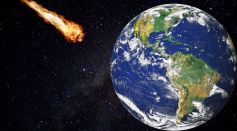Tags: Earth

NASA Perseverance Rover Help Scientists See Ancient Rock From Mars’ Surface; Signs of Flowing Water Revealed
Plate Tectonics Weaken as They Sink; Research Reveals Pieces of Crust of Earth Bend Upon Entry in the Mantle

Speed of Human-Caused Global Warming Over the Last 150 Years Has Increased at a Level Not Seen Since the Last Ice Age

Blue Origin’s Jeff Bezos Predicts Earth Will Be a 'Natural Resort' and Only Few Will Be Allowed To Stay
Planet Now Has 7,500 Low-Earth Orbit Satellites, More Than 30,000 Manmade Floating Objects
Mineralogist Discovers Mineral 'Davemaoite' Trapped In a Diamond From Earth's Mantle
Planet 9: British Astronomer Claims He Saw Another Globe In The Solar System; Is It Real?
Earth's Constant Companion Asteroid As Big as a Ferris Wheel Could Be A Fragment of the Moon, Study Suggests
NASA DAVINCI Mission: Soar Through Venus’ Atmosphere With This Stunning Footage [Watch]

Partial Lunar Eclipse: When, Where, How You Can See the Different Phases Of Moon Occurrence on November 19

NASA Detects Massive Asteroid Similar to the Size of Dubai’s Burj Khalifa Passing by Earth in Mid-December; Should We Worry?
Partial Lunar Eclipse Will Be High in North American Skies: Here's When and Where It Will Be Visible
Earth's First Continents Emerged From Ocean 700 Million Years Earlier Than Previously Thought

NASA Detects Asteroid as Big as Eiffel Tower Passing by Earth Next Month; Should We Worry?
How Can Digital Twin Earth Help in Saving the World? ESA Develops an Advanced Model to Address Problems Caused by Climate Change

Longest Partial Lunar Eclipse of the Century: How to Watch This 3-Hour Phenomenon

Is NASA’s Top Priority the Discovery of Other Kinds of Life and Possible Habitat Apart from Earth?

Massive Solar Flare Continues to Hit Earth: Flights, GPS on Red Alert But Geomagnetic Storm Does Not Affect Airline Workers, Passengers
Will Crashing Into an Asteroid Change its Course? NASA Plans to Test This Theory In Case of a Real-Life Armageddon
What Caused the End-Ordovician Mass Extinction? Cooling Climate Might Be Responsible Not the Lack of Oxygen
Most Popular

How AI Is Used in Weather Prediction: Smarter Forecasting Through Machine Learning

The Future of Clean Tech: Exploring the Next Generation of Renewable Energy Breakthroughs

De-Extinction vs. Conservation Science: Which Approach Protects Biodiversity Most Effectively?

Geoengineering and Climate Intervention Science: Can We Really Engineer a Cooler Planet?





